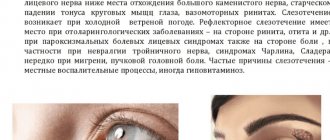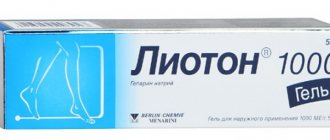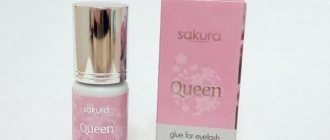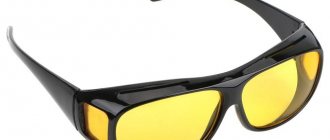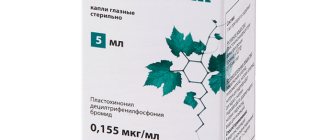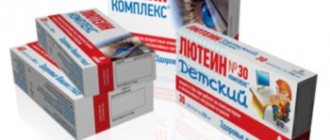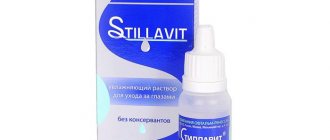Causes of teary eyes
In order for the ophthalmologist to correctly select medications for the patient, he needs to identify the cause of increased lacrimation. The most common of them in medical practice include:
- Colds and inflammation of the paranasal sinuses. With this disease, the paranasal sinuses are blocked because the nasal septum swells. This puts increased pressure on the tear glands of the eyes.
- Irritants from the external environment. These may include some natural phenomena: excessively bright lighting, strong winds, snow or rain. In such conditions, tear production works as a protective function.
- Tired eyes. Tearfulness often occurs in people who place a lot of strain on the visual system. For example, they spend a long time looking at a computer monitor, reading, or staying awake for a long time.
- Allergic reactions. In this case, tearfulness can be observed under certain conditions, that is, the presence of an irritant, or be characterized by seasonality.
- Infectious eye diseases. If the patient has an infectious pathology, tearfulness may first appear in one eye and then move to the second.
- Violation of hygiene rules.
- Incorrectly selected means of contact vision correction.
How anti-tear eye drops work
The effectiveness of eye drops is explained by the fact that they directly indicate an immediate effect on the cause of the symptom. Any discomfort (pain, redness, increased sensitivity, etc.) after using the drops should go away within a few minutes. However, if the cause of tearing is associated with internal disorders in the body, for example, with an allergic reaction, then it is impossible to eliminate the disease with eye drops alone, despite the fact that they effectively combat the symptoms. In this case, additional treatment with drugs aimed at treating allergies will be required.
What else is important to know about treatment with drops
Tearfulness is not a disease. This is an unpleasant symptom that causes significant discomfort to anyone. In addition, excessive tear flow may indicate the development of some serious ophthalmological disease.
Be sure to consult your doctor if this problem plagues you on a regular basis.
Remember that there will be no effect from using drops if the drug is chosen incorrectly.
During treatment you should adhere to the following rules:
- Before applying eye drops, remove all makeup from the surface of the skin. You will also need to remove your contact lenses. During treatment, it is recommended to completely stop using cosmetics. So as not to create additional irritation on the eyes.
- Before instillation, be sure to wash your hands thoroughly with antibacterial soap.
- Make sure that the plastic bottle does not touch the mucous membrane of your eye during instillation. Otherwise, there is a risk of spreading the infection.
- You need to instill eye drops while lying down so that the active components are better distributed throughout the mucous membrane. Also, after instillation, you need to lie down for several minutes.
- Immediately after instillation, it is not recommended to do work or drive - the picture may float.
- It is strictly forbidden to use eye medications that have expired.
Drops for lacrimation: types
There are different groups of drops to eliminate tearing. Each of them is reassigned not only to eliminate the symptom, but also fights the cause of its occurrence.
The main types of such eye drops include:
- Antihistamines - indicated for patients with manifestations of allergic reactions. Such drugs are blockers of the immune system's reaction to the allergen; they relieve inflammation and irritation of the visual organs in a short time.
- Anti-inflammatory - reduce pain, inflammation and redness.
- Antibiotic drops - prescribed for bacterial infections.
- Preventative - necessary to prevent symptoms, often prescribed to patients with dry eye syndrome.
- Combined - have a broad effect and can eliminate various symptoms and causes of the disease.
- Moisturizers with artificial tears are prescribed in the presence of lacrimation caused by improper selection of contact lenses.
Anti-tear eye drops for older people
Elderly people, due to irreversible changes in the body and visual system, may experience increased tearfulness. Often the problem may be the presence of dry eye syndrome.
The selection of drops for older people should be carried out by an ophthalmologist and be aimed at the root cause that caused tearfulness. If the patient has eye inflammation, it is advisable to use drops containing antibiotics, for example, Diklo-F, Okomistin, Indocollir. And if the problem does not lie in the presence of an infection in the visual system, then full restoration of the functioning of the lacrimal glands is possible with the help of eye drops with artificial tears.
What to do if an elderly person's eyes are watery
If an elderly person's eyes are watery, the first thing to do is the following.
- Eliminate visual stress. This means reducing time reading, watching TV, and working on the computer.
- Take vitamins. Tearfulness is often observed in older people with weakened immune systems. To strengthen it, you need to take vitamins and consume a lot of fresh vegetables and fruits.
- Avoid eye strain. This is necessary if the problem is caused by wearing contact lenses or glasses. It needs to be stopped for a while. In the future, you should choose other lenses or glasses in consultation with an ophthalmologist.
- Avoid contact with the irritant. If the problem is caused by an allergic reaction, it is necessary to exclude the elderly person from contact with the allergen as quickly as possible.
As for taking medications, it is permissible only after consultation with your doctor. It is unacceptable to decide on treatment with medications: this can cause significant harm to the health of an elderly person.
Eye drops for watery eyes on the street
Excessive tearing of the eyes on the street can be associated with a variety of factors; it is on the basis of these that the doctor selects drops for the patient.
If a person complains of increased dryness of the visual organs, to moisturize the mucous membrane, he is prescribed eye drops for watery eyes such as Vizin, Lakrisin, Vidisik and others. If you develop an allergy, for example, to dust or pollen, you can use Azelastine or Opatanol. If a person has excessive eye sensitivity caused by external environmental irritants (bright sun, cold, wind), ophthalmologists recommend using vasoconstrictor drops against tearing of the eyes, for example, Visine. It is also recommended to additionally protect the visual organs with glasses.
Features of choosing funds
Anti-lacrimation eye drops for older people need to be chosen correctly. After making an accurate diagnosis, the ophthalmologist begins to prescribe adequate treatment. Drug therapy may include ointments, gels and eye drops. Hypersensitive patients need to take an allergen test in advance to identify possible intolerance to certain medicinal components.
When purchasing a medication, you need to carefully read the composition. High-quality medicines should not contain chemicals (borates, boric acid, thiomersal, mercury derivatives). The composition may contain polyquart, benzalkonium chloride, chlorobutanol and chlorhexidine.
When choosing anti-lacrimation medications, you cannot rely on advertising and the opinions of friends. Each medication acts individually depending on the characteristics of the patient’s body. It is necessary to carefully study the instructions for use and become familiar with the main contraindications.
Effective drops to eliminate watery eyes
The modern ophthalmological market is filled with a large number of drugs that combat tearing. The prescription or other remedy is made based on the diagnostic results and depends on the severity of the disease, as well as the financial capabilities of the patient.
Let's present a selection of the most effective and popular drugs:
- "Opatanol" - fights allergic reactions of various origins, including seasonal keratoconjunctivitis and hay fever. The drops are produced in small bottles and have a yellow tint; they are used exclusively topically during the period of symptoms.
- "Octilia" - indicated for irritation of the mucous membrane of the eyes, excessive tearing, swelling and burning. The drops have a vasoconstrictor function and are suitable for patients with conjunctivitis. The dosage is determined by a specialist individually.
- "Allergodil" - eliminates itching, burning and lacrimation of the visual organs. Eye drops are not addictive. Can be used throughout the year if allergic reactions occur.
- “Lecrolin” is prescribed when acute inflammatory processes in the visual apparatus are detected in a person. The drug can only be used as prescribed by a doctor. It is also not recommended to use it beyond the specified dosage and period; make sure there are no contraindications.
- "Vizin" - indicated for eye fatigue, allergies and redness of the mucous membrane. Can be used throughout the day, the drops are not addictive and have a minimal list of contraindications.
- “Prenacid” is a broad-spectrum hormonal drop. Prescribed for excessive lacrimation caused by infection or allergic reactions of various origins. Not recommended for use by children and pregnant women.
- "Kromhexal" - used for exacerbation of allergies and severe dry eyes. Drops can also be used for preventive purposes. The dosage is prescribed individually to each patient.
The main types of drops for tearing
Before choosing a drug, you must visit an ophthalmologist. The specialist conducts a comprehensive diagnosis to identify hidden causes of tearing. If an infection is suspected, additional tests may be required. Depending on the result, he recommends the following drops:
- Antibiotic based. They contain anti-inflammatory and antibacterial components, eliminate the cause, improving the condition of the mucous membranes.
- Anti-inflammatory. Used after surgery, injury, in complex treatment, relieve irritation and redness of the sclera.
- Combined. They contain various substances, relieve inflammation, and at the same time improve nutrition and blood supply to the organ of vision.
- Moisturizing. Recommended for maintaining balance when wearing lenses or working at a monitor for long periods of time.
In each case, the drugs are chosen individually. They are often combined with taking vitamin complexes, antibiotics and rinsing with an antiseptic.
A separate category of patients are people over 55 years of age. Due to natural reasons and age, the glands work with an increased reaction to any irritants. Watery eyes irritate the mucous membranes and visual acuity decreases. For inflammation, doctors recommend complex drops of Okomistin or Indocollir and prescribe a course of treatment to maintain the optic nerve.
With increased dryness while working at the computer, lacrimation often occurs in bright light and sunlight.
It is difficult for the eyes to adjust to the new spectrum, so a defensive reaction occurs. Hypersensitivity develops, which worsens in the wind and cold. In such situations, you can use Visin drops or other drugs with a moisturizing effect.
Read more How to use Duotrav eye drops: instructions and reviews
Cationorm
This is a unique cationic emulsion to eliminate dry eyes, which does not contain preservatives, renews all layers of the tear film, providing long-term relief from intense discomfort. Cationorm prevents the development of dry eye syndrome and helps combat lack of hydration at any time of the day. Cationorm can be used directly on contact lenses. Indications for use:
- - pronounced or moderate dryness, even in the morning;
- - use of contact lenses;
- - eye diseases: glaucoma, blepharitis, allergic conjunctivitis.
When applied, Cationorm is evenly distributed over the ocular surface and does not cause discomfort.
Okutiarz
These are eye drops based on hyaluronic acid and do not contain preservatives. They are suitable for quickly relieving eye discomfort and fatigue that occurs at the end of the day or after intense visual stress. Ocutiarz can be instilled directly onto contact lenses. It is often prescribed to relieve discomfort after ophthalmic surgery on the cornea. Indications for use:
- - dry eyes in the evening;
- - eye fatigue after long visual work;
- - use of contact lenses;
- — the first 6 months after eye surgery (LASIK, PRK, cataract extraction).
Ocutiarz is well tolerated by patients, since hyaluronic acid is a component of natural tears and promotes healing of the ocular surface after ophthalmic surgery. Made in France. Shelf life 6 months after opening.
Oftagel
This is an eye gel with a maximum concentration of carbomer, which provides a feeling of long-lasting hydration, eliminates watery eyes and does not require frequent use.
Advantages of Oftagel:
- — optimal portability among gels due to a more fluid form;
- - one application per day is enough;
- — made in Germany;
- - low cost.
Oftagel is indicated for use by people with complaints of general discomfort, variable dry eyes, lacrimation and reluctance/inability to instill drops more than once a day.
Okomistin
The drug is an innovative antiseptic that eliminates inflammation and irritation. The drops contain an antimicrobial component with a pronounced antibacterial effect. Therefore, the drug is used in the complex treatment of infections caused by staphylococci, streptococci, herpes, and adenoviruses. It helps reduce lacrimation in the following diseases:
- conjunctivitis;
- keratitis;
- blepharitis;
- thermal burns.
Okomistin is recommended for complex therapy of rhinitis or sinusitis, eliminating swelling and pressure on the lacrimal glands. Used to prevent complications from otitis media, mycosis, and sinusitis. Suitable for treating children and women during pregnancy at any stage, safe during lactation.
Allergodil
It is recommended to use for increased tearing caused by allergic conjunctivitis. A drug based on azelastine has an anti-inflammatory and calming effect. It reduces capillary permeability, normalizes the functioning of receptors, eliminating the cause of irritation of the glands.
Among the disadvantages are frequent complications and side effects:
- increased swelling;
- skin itching;
- dizziness;
- muscle weakness;
- hives.
Allergodil drops are used in the treatment of children over 6 years of age, but are not allowed during pregnancy. They can be prescribed in long courses of 7–8 weeks, but an addictive effect gradually develops. It begins to act quickly after administration, allowing the patient to drive vehicles and do work without unpleasant lacrimation.
Read more How to choose ear plug drops
Octilia
In case of severe irritation and tear production, it is recommended to use alpha-adrenergic agonists, which relieve vascular tone, narrow their lumen, eliminating the cause of inflammation and discomfort. The active substance tetrizoline hydrochloride eliminates swelling and redness, linden and chamomile extract nourishes tissues, improving the condition of the mucous membranes.
Main indications for use of Octilia:
- complex therapy for conjunctivitis or blepharitis;
- irritation upon contact with chemical factors;
- work behind the monitor;
- recovery after surgery or injury.
Sometimes side effects occur in the form of increased intraocular pressure, itching and redness of the sclera. Contraindications are glaucoma, age under 3 years, diabetes mellitus and cardiac arrhythmia. Drops should be used with caution during pregnancy and lactation, and while taking antidepressants.
Tobrex
Therapeutic drops are broad-spectrum antibiotics. The base is boric acid, benzalkonium chloride and sodium sulfate. The combination of components relieves inflammation by disrupting protein synthesis and destroying pathogenic microflora. As the cause is neutralized, lacrimation and unpleasant symptoms decrease.
Tobrex can be used in the treatment of diseases caused by:
- Klebsiella;
- enterobacteria;
- salmonella;
- staphylococci.
Drops cope with increased lacrimation in severe infections, which are accompanied by suppuration and blockage of the lacrimal glands. Can complement systemic therapy for sepsis, sinusitis, meningitis, acute otitis media with edema of the appendages. Sometimes it provokes headaches, lethargy, and local allergic reactions.
Visine
Effectively eliminates increased lacrimation caused by dry eye syndrome. Contains the adenaline stimulant tetrizoline, which constricts blood vessels and reduces swelling of the conjunctiva. This reduces the formation of intraocular fluid for 6-8 hours after use.
Main indications for the use of Visin:
- irritation due to dry eye symptoms;
- contact with smoke, dust, chemicals;
- seasonal allergies.
Therapeutic drops are well tolerated, rarely cause side effects, and do not cause irritation. They can be used over a long course, but with careful adherence to the dosage. Otherwise, a reaction develops, which is accompanied by increased blood pressure, convulsions, indigestion, and nausea.
Cromohexal
When allergies worsen, doctors prescribe Cromohexal drops with the active ingredient sodium cromoglycate. It releases prostaglandins, which relieve discomfort, soreness and lacrimation. In addition, histamines act to stop the allergic reaction.
Cromohexal has a cumulative effect that manifests itself over several days. For preventive purposes, drops are used for dry eye syndrome. They are included in treatment for the following diseases:
- keratitis;
- keratoconjunctivitis;
- inflammation after injury.
Drops can be used from the age of 2 years no more than 4 times a day. The average course of treatment is 3–4 weeks. Not recommended during pregnancy, kidney or liver failure.
Lotoprednol
For blurred vision and lacrimation in older people, Lotoprednol drops are used. They moisturize and cleanse the cornea, relieve redness, itching, burning in blepharoptosis, Sjögren's syndrome, and blepharitis. They help eliminate side effects when taking certain medications for sclerosis or hypertension.
Read more List of the best anti-colic drops for newborns
Lotoprednol drops contain a hormonal component and the antibiotic tobramycin, which regulate the activity of the lacrimal glands and eliminate inflammation. Indispensable for allergies and severe swelling pressing on the optic nerve. In old age, Lotoprednol is not used for cataracts and glaucoma, exacerbation of herpes infection.
Not prescribed for children under 6 years of age.
Opatanol
A strong antihistamine based on olopatadine. It has a pronounced anti-allergic effect, relieves lacrimation in seasonal allergies. Opatanol drops calm serotonin and dopamine receptors, reducing swelling that puts pressure on the lacrimal glands.
In rare cases, Opatanol provokes side effects:
- blurred vision;
- burning;
- redness in the corners of the eyes;
- keratitis.
In rare cases, headache and runny nose may occur. For severe allergies, the course of treatment is 3–4 weeks. Drops can be combined with other medications for inflammation or pain. On average, symptoms of the disease and lacrimation disappear within 4–5 days.
Sanorin–Analergin
Drops with a pronounced vasoconstrictor and antiallergic effect. They contain naphazoline, an adrenergic agonist that quickly eliminates swelling and inflammation during exacerbation. Complete relief and reduction in lacrimation is observed on the 5th day. The inexpensive drug is not recommended in pediatrics for the treatment of children under 16 years of age.
Contraindications for use are:
- bronchial asthma;
- hypertension;
- angina pectoris;
- prostate tumors.
The drug blocks receptors that provoke allergies and the secretion of tear fluid. Therefore, it is necessary to observe the dosage so as not to provoke dry mucous membranes. In rare cases, it causes surges in blood pressure and tachycardia.
Lecrolin
Drops are used for lacrimation caused by allergies to pollen, animal dander, keratitis and conjunctivitis. Relieves symptoms when exposed to chemical irritants, side effects of cosmetics or eye mascara. Easy to dose, can be used up to 4 times a day.
Lecrolin is a cheap drug of good quality with a minimum number of contraindications. It is prescribed for the treatment of children from the age of 4 years, under the supervision of a doctor it is recommended for pregnant women. In rare cases, local allergic reactions occur in the form of burning, itching or redness of the sclera.
Inexpensive anti-lacrimation medications
The most inexpensive and at the same time effective means for combating severe lacrimation include:
- moisturizing the mucous membrane of the eye - “Opcon-A” and “Vizin”;
- antibacterial and anti-inflammatory - “Gentamicin”, “Torbex”, “Levomycetin”, “Normax”, “Albucid”;
- hormonal, broad-spectrum - "Dexamethasone";
- antiallergic - "Lecrolin" and "Opatanol";
- vasoconstrictors - “Tobradex” and “Sofradex”.


